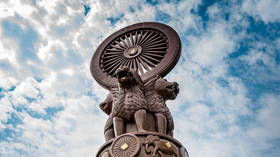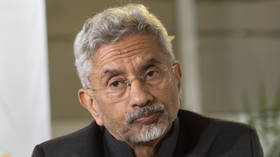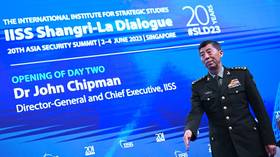Will Biden’s best salesman charm India into the arms of the US?

US President Joe Biden’s administration is working overtime to give top billing to Indian Prime Minister Narendra Modi’s official state visit to the US from June 21 to 24 in a key election campaign year. The visit will be Modi’s sixth to the US since he assumed office in 2014.
Biden wants to present Modi’s upcoming trip as being bigger than the Indian premier’s Manhattan moment in 2014 when he was hosted by Barack Obama, and Howdy, Modi! in 2019 during the Trump administration.
To that end Biden sent his trusted aide, US National Security Advisor (NSA) Jake Sullivan, to New Delhi on a two-day trip on Tuesday, to lay the groundwork for the high-profile event, and build upon last week’s visit to India by US Defense Secretary Lloyd Austin.
Prominent Indian geopolitical commentator, C Raja Mohan, has suggested that Sullivan’s visit may pave the way for Modi’s Deng Xiaoping moment in leveraging India’s unique situation into significant gains for the country. However, the current global churn is many times removed from the visionary Chinese leader’s time in office last century, and the US is more transparent in its efforts to create a unipolar world order.
Sullivan’s agenda
Economic cooperation is at the heart of the Sullivan’s India trip. The top US security official held talks with Modi, his Indian counterpart, Ajit Doval, and minister for external affairs, Dr Subramanyam Jaishankar, on a range of issues that go beyond the optics of bilateral diplomacy. Doval and Sullivan also attended the second Track 1.5 dialogue on the Critical and Emerging Technologies (iCET) initiative, which was organized by the Confederation of Indian Industry (CII).
They unveiled an ambitious roadmap for Indo-US collaboration in seven specific hi-technology areas, including semiconductors, next-generation telecommunications, artificial intelligence and defense.
Sullivan said the iCET is about people-to-people relationships, building skills, trust and confidence between the societies and governments of the two countries. He said it is also a way to deepen defense cooperation that will help both the countries strategically and economically.
Meanwhile, Modi’s upcoming US visit has been heralded as a new era of “future ties” amid a “robust outcome document” that is in the works. However, the underlying motive is the desperate US desire to gain access to one of the biggest markets in the world following its deteriorating trade and diplomatic ties with the world’s second biggest economy – China.
Sullivan is playing the role of a traveling salesman, hawking US interests in key global capitals much like before his elevation to the NSA.
On this trip, he pulled out all stops to impress upon the Modi government the ease of doing business with the Biden administration, which is all but a lame duck, ahead of a key election to be held later this year.
Sullivan’s talks centered on opening a $2.7 billion semiconductor chip-making facility in India by Micron Technology, which is headquartered in Boise, Idaho and sharing technical know-how regarding quantum computing technology. India imports about 80% of its semiconductors.
New Delhi is believed to be wooing Intel Corporation to set up shop in the country following fears of a disruption in supply chains in light of escalating tensions between China and Taiwan.
Significantly, the pièce de resistance is Sullivan’s last-ditch bid to jointly manufacture US aircraft engines for Indian defense forces by General Electric (GE) in partnership with state-run Hindustan Aeronautics Limited (HAL). Will the transfer of technology (ToT) be a fillip to Modi’s ambitious “Make in India” initiative? ToT is a key aspect in Indo-US bilateral relationship, where past misadventures such as the 2008 civil nuclear agreement between the two nations stick out like a sore thumb. The US is dragging its feet over ToT unlike Russia, which has been an all-weather ally to India.
Biden has unpacked the top brass in his administration ahead of Modi’s visit. China – the elephant in India’s room – also figured prominently during Sullivan’s trip because he is being accompanied by US Indo-Pacific Coordinator at the National Security Council Kurt Campbell.
Washington has been raising the China alarm with New Delhi and accuses Beijing of flexing its military muscle over Taiwan and the South China Sea while underscoring India’s primacy in the elite grouping of the Quad.
Truth be told, since its revival in 2017, the grouping largely remains a non-starter as questions abound whether it is hitting the right notes to keep a belligerent China at bay.
The US is seemingly ratcheting up further bilateral tensions between the two most populous nations and nuclear-powered neighbors as a means to insert itself as part of India’s solutions to security.
How does the US hypocrisy stand exposed?
Public memory, as the cliché goes, is short indeed. In 2005, PM Modi was denied a US visa because of his alleged role in the Gujarat pogrom against minority Muslims in the western Indian state in 2002, when he was the Chief Minister.
The US changed its tune in 2014 after Modi’s right-wing Bharatiya Janata Party (BJP) enjoyed a landslide win against the incumbent Congress-led opposition alliance.
US State Department spokeswoman Jen Psaki had said Modi would receive a visa to the country once he took office and formed a government. And an AI visa, which is the eligibility norm for all heads of state, was made available to him. Washington then started making overtures towards him in a true bipartisan manner with Obama, Trump, and now Biden have been rolling out the red carpet for him as they seek to tap India’s growing middle class, whose strength is more than the total US population at last count.
But such foreign policy misadventures have been the hallmark of the US in the name of championing democracy in all corners of the globe for which the UK fell for hook, line and sinker.
With such checkered records and doublespeak, should the Modi government be enamored by Sullivan’s charm offensive?
The US seldom delivers what it promises, if its deeply flawed foreign policy is a marker of Washington’s overreach.
Is the Biden administration on the same page?
There is a lack of clarity regarding whether the Biden administration’s various arms share Sullivan’s enthusiasm about Modi and India. Historically, the US State Department has been hostile towards New Delhi about ramping up bilateral engagement in the field of defense and hi-tech.
However, the jury is still out whether Sullivan, aided and abetted by the Pentagon, can ensure joint manufacturing of GE’s F-414 engine in India, which if Washington manages to pull off, will go down in the annals of history. At the same time, it will open a new front in the Arab world in the Middle East, where the US has been arming them to the teeth in the name of twin threats from Iran and Israel. President Biden’s largesse may help India’s state-run Defense Research and Development Organization (DRDO) to indigenously develop the Tejas Mark II fighter aircraft for the Indian Air Force. US defense majors are also looking for an opening to manufacture other hi-tech weapons including loiter bombs, air-to-air missiles and long-range guided bombs amid stalled arms supplies from Russia owing to fear of disruption in payment mechanisms over US-led Western sanctions on the ongoing special military operations in Ukraine. Sullivan aims to reboot several existing mechanisms such as upping the ante in sectors such as telecommunications, rare earth metals mining and space. Both NSAs discussed this during a meeting on Critical and Emerging Technologies (iCET) in Washington on January 31.
The mechanism received a boost during the first India-US Strategic Trade Dialogue meeting in Washington on June 4 and 5.
US commerce secretary Gina Raimondo’s visit to New Delhi in March was a precursor to this high-level engagement that set the stage for Sullivan’s trip to iron out the rough edges in the bilateral ties.
Is Sullivan the ace of spades for Biden?
The New York Times stated in 2021 that Sullivan, who has been equated with Henry Kissinger, has long been a “figure of fascination, somewhere between sympathy and schadenfreude.” He has been Biden’s go-to man for all reasons and seasons. He held crucial talks with key Chinese officials and has a similar historic opportunity to make Modi seem to be a global leader, whose life has come full circle since Washington dubbed him a pariah. And time is of the essence as Biden’s fate is likely to be decided in a few months, even though Modi’s hold on power appears to be as firm as ever.
Sullivan had an inkling about Russia’s special military operations in Ukraine a couple of months before the conflict started in February of 2022. He tried to shape global opinion against Russia, including pushing through the sanctions. Has he managed to strengthen NATO, including Finland’s membership, is an open-ended question?
His speech at the Brookings Institution in April laid bare the growing US challenges amid a new pivot known as the ‘new Washington Consensus’, a euphemism for geo-economics. How much has he achieved will be judged by posterity.
Sullivan has been single-mindedly pushing for a technological alliance with “trusted partners” such as India to stymie China’s dominance.
The Indo-Pacific maritime is his other pet project that has grabbed the headlines, even though he is not a foreign policy hawk. He seeks to be on an even keel with China, especially his recent engagement with Foreign Minister, Wang Yi.
India, according to Sullivan, connects all these dots, despite New Delhi’s deep historic ties with Moscow. But can the US play a “long game” since the presidential election may change the foreign policy outreach in the next few months.
Biden’s last hurrah?
According to a report in The Washington Post, the US seeks to expand the developing world’s influence (read India) at the United Nations (UN). This hurriedly-thought through bid appears to empower the UN Security Council (UNSC) because of the latter’s ineffectiveness as a global body to stop conflicts such as the ongoing military standoff in Ukraine. This mechanism, which has long been in the works, is also Washington’s bid to push through a unipolar world narrative and keep Russia and China out of the frame. Wooing India helps because it is part of the strongest anti-US bloc in BRICS, where Brazil and South Africa bring up the rear, to create an alternative world order.
Linda Thomas-Greenfield, President Biden’s envoy to the UN, is reportedly consulting with diplomats from the organization’s 193 member states to gather feedback about a potential expansion of the UNSC ahead of world leaders’ annual gathering in New York in September.
But Washington is unlikely to create a consensus in a fractured world, where the US is seen as a perennial big bully. Besides, it’s unclear which countries in the Global South and from Africa and South America are likely to make the cut.
For instance, any nation such as Venezuela, Cuba, Egypt and Morocco will not be welcome to join the exclusive club because of their close ties with Russia and by extension are considered as rogue states by the US.
The US is unlikely to have its way because India’s seat at the global high table will be opposed tooth and nail by Pakistan.
A tricky road for Modi
Modi, who is known to have an elephant’s memory, may do well not to bite the US bullet ahead of his re-election next year, where he appears to be in the driver’s seat, despite a few recent domestic setbacks.
As for Biden, it could be a classic case of too little, too late to woo American voters with last-minute optics. The maxim “It’s the economy stupid” could seal his fate for a second-term in the White House. His historically low approval ratings are an indictment for lording over an economy that’s teetering on the brink, despite his lofty pronouncements of a rosy outlook.


















